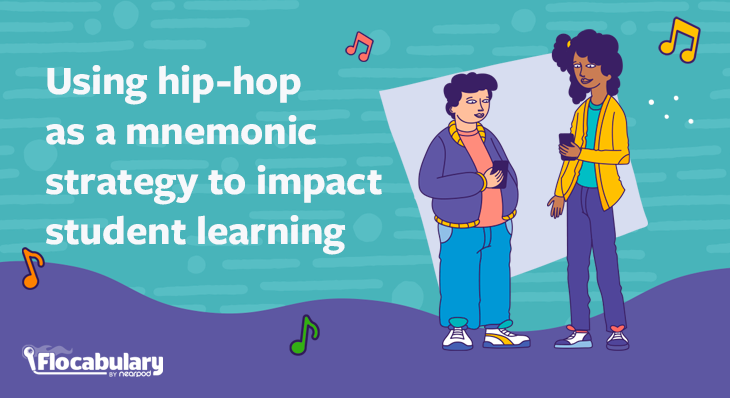
Using hip-hop for mnemonic strategies to impact student learning
What are mnemonic devices?
Mnemonic devices are sometimes simple rhyme phrases, which can make it easier to capture and retain information. Another typical mnemonic strategy is naming. The University of Nebraska-Lincoln defines a mnemonic as an instructional strategy to improve the retention and recall of information through visual or auditory clues. These clues improve students’ ability to make connections between their existing knowledge and new information. One example of this would be remembering the names of the Great Lakes using the acronym HOMES (these would represent Lake- Huron, Ontario, Michigan, Erie, and Superior). Musical mnemonic strategies are a third example we will look at. One study (Murakami, 2017) looked at musical mnemonics’ effect on older adults and concluded that participants saw an increase in their ability to recall information verbally. Mnemonics for memory are the center of why we use mnemonic devices for learning.
How can Flocabulary support teaching with mnemonic devices?
Flocabulary has established itself as a uniquely engaging way to get students excited about their learning. This is evident in our videos, where students can be seen bobbing their heads and reciting the lyrics to songs that ultimately tie them to the rigorous content aligned with the academic standards in the state where they live.
The Flocabulary lesson sequence is intentionally designed to move students up Bloom’s Taxonomy. It begins with our tailored videos to help students remember and extends to the Lyric Lab, which represents Bloom’s highest level of creativity. Ultimately, we know this approach is effective and works to help students become better, well-rounded critical thinkers. How we do this is layered in various learning strategies we have incorporated into Flocabulary’s lesson sequence. Many of these strategies have been proven to increase student reading proficiency by themselves as a standalone concept. That said, let us look at Flocabulary through the lens of mnemonic devices as an instructional tool.
Hip-hop offers a dynamic approach to storing information through the clever integration of mnemonic strategies. From spelling mnemonics to keyword associations, the genre’s rhythmic flow provides a unique platform for students to engage with understand, and retain various types of information. By harnessing the power of hip-hop, educators can transform common mnemonics into catchy rhymes and hooks, enhancing retention and making learning more memorable.
New to Flocabulary? Teachers can sign up for a trial to access our lesson videos and assessment activities. Administrators can get in touch with us to learn more about unlocking the full power of Flocabulary through Flocabulary Plus.
How to use hip-hop for mnemonic strategies to impact student learning
The power of rhyme in the classroom
Think about it like this: rhyme is learning what wings are to glide. Sure, one could learn something new without rhyme, just as a flying snake gracefully glides across terrain without wings. Still, you must admit that having wings would make flying and gliding much easier. That’s what rhyme does for learning. It makes it easier! These mnemonic strategies can be applied at almost every step in one’s educational journey. We see evidence of the use of mnemonic devices as early as preschool, where the ability to recognize, combine, and manipulate worlds lends itself, eventually, to the development of students’ writing and reading skills.
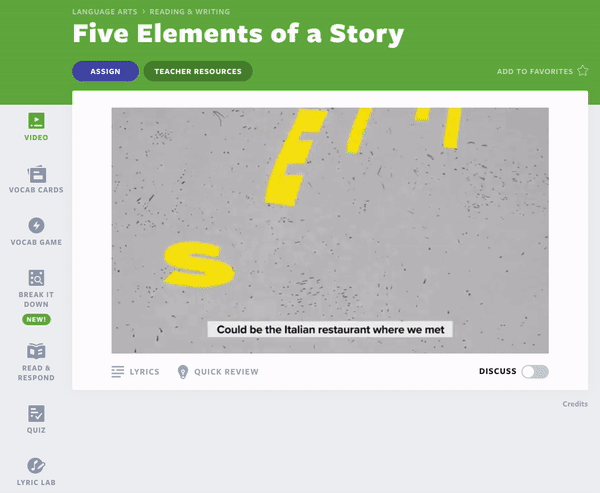
Take, for instance, the use of mnemonic devices in a nursery rhyme. The repetition in “Three Blind Mice” is a great mnemonic example of them being used to impact memory. Most programs providing reading instruction are anchored with opportunities for students to work on their rhyming skills. There have even been direct correlations between a student’s level of phonological awareness and their reading ability. One study, Beaumont, 2022, showed how rhyme helps students improve oral language skills, comprehension, and vocabulary acquisition.
“To me, playing an instrument and singing, all of these different things are just as natural to me as rhyming.”
Mos Def
How to use mnemonics for memory with rhyme and rhythm
Using rhyme for learning is the heart of Flocabulary. There are a few components within the platform where you can clearly see the use of mnemonic techniques for memory. First, and probably the most obvious, are our videos. Flocabulary has over 1,300 video-based lessons with supporting activities across K-12 subjects. You can hear lyrics ranging from the most simplistic of rhyme formats to some of the most complex in each.
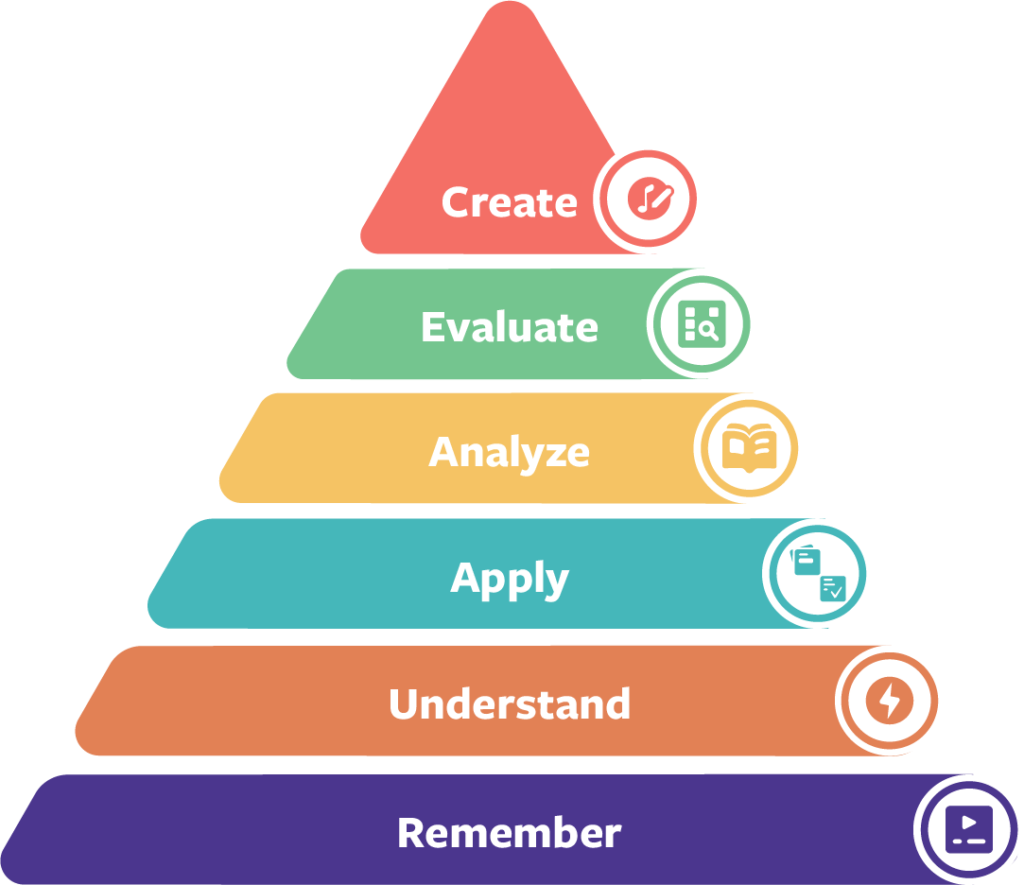
Our Flocabulary video component aligns with Bloom’s Taxonomy of learning by assisting students with ‘remembering’ the explored content. On the opposite end of Bloom’s, and at its highest level, is the concept of ‘creating’. This is delivered through our Lyric Lab activity, which is embedded in every one of our video-based lessons. Students are challenged to create original song lyrics or poetry using the Lyric Lab feature. More often than not, students will choose to complete the activity using a rhyme scheme.
Educators who are not inclined to create poetry, let alone lyrics to original songs, might find this activity a bit intimidating. WE know this, and we are here to support you! Lyric Lab includes a vocabulary word bank and a rhyme generator students can use to write their own lyrics. They can also select a unique beat to go with their rhymes!
The following briefly describes key rhyme styles that will help guide students through the rhyme-writing process using Lyric Lab.
Teaching mnemonic examples through rhyme schemes
There are various types of mnemonics and rhyme schemes. Wikipedia defines rhyme scheme as the pattern of rhymes at the end of each line of a poem or song. It is usually referred to by using letters to indicate which lines rhyme; lines designated with the same letter all rhyme with each other. Let us take a look at three popular rhyme schemes used in writing hip-hop songs, along with a few original examples from one of your favorite Flocabulary emcees. The three most commonly used rhyme schemes in hip-hop are AABB, ABAB, and AAAA.
AABB rhyme scheme
The AABB rhyme scheme was commonly used by emcees in the earliest days of hip-hop music and is still used today. Modern-day emcees often make these rhyme couplets more complex than their early predecessors. Basically, every two lines of the lyrics will end with matching rhyming words. Let’s look at mnemonic strategies using an original flow done just for you:
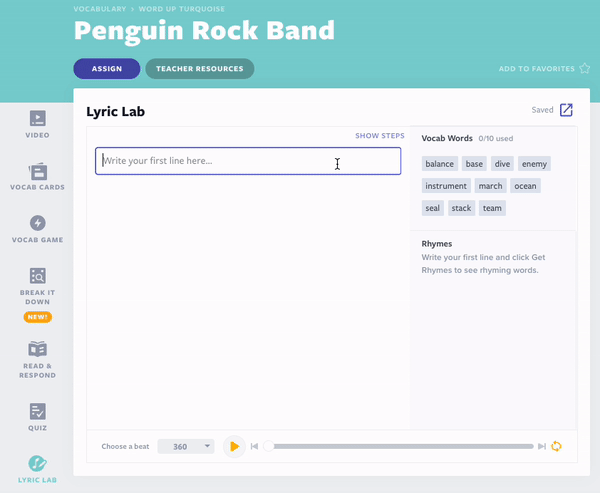
I can’t believe it, but I’m trying to learn something new (A)
Wait a minute, hold up, Here’s what we got to do (A)
Play a beat, write a rhyme, and do it really good, (B)
If you have never tried Flocab you really should! (B)
Okay, let’s look at this same scheme with a more modern twist or play on words by adding internal rhyme to each of the lines.
What it do, is it true, here’s something new (A)
Tell the crew not to move we bout to do the do! (A)
And if you would drop a beat, I’ll make the rhyme good, (B)
You never understood Flocab, you really should! (B)
ABAB rhyme scheme
Now, let’s look at the ABAB rhyme scheme. Basically, when using ABAB, the writer alternates every rhyme. The actual rhyming end word is delivered in every other bar or line.
I can’t believe it, but I’m trying to learn something new (A)
Play a beat, write a rhyme, and do it really good, (B)
Wait a minute, hold up, Here’s what we got to do. (A)
If you have never tried Flocab you really should! (B)
Okay, as with the last rhyme scheme, let’s look at this scheme with a more modern twist or play on words…
Who knew what to do we were learning something new (A)
The beats and the rhymes we understood that was all good, (B)
In a few, run and tell the crew what we about to do! (A)
You never understood Flocab, you really should! (B)
Admittedly, the ABAB rhyme scheme can be tricky, especially when you bring a more complex approach to writing lyrics in this style.
AAAA rhyme scheme
Now, let’s end the mnemonic strategies with the AAAA style. Also known as monorhyme, the AAAA rhyme scheme ends every set of four lines with the same sounding rhyming word or phrase:
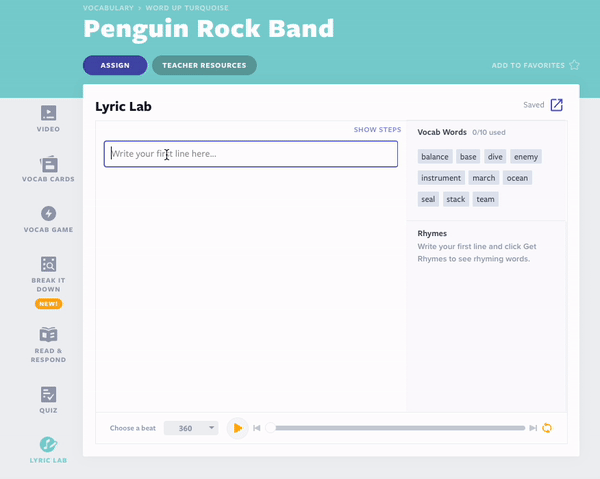
Who knew what to do we were learning something new (A)
The beats and the rhymes we understood that was all good, (A)
In a few, run and tell the crew what we about to do! (A)
Every hood, from the cities to the woods, do it how Flocab should (A)
I can’t believe it, but I’m trying to learn something new (B)
Wait a minute, hold up what have we got to do? (B)
Make the beat, say the rhyme, and create a tune (B)
It’s Flocabulary, and you better try it soon (B)
Personally, I love this rhyme scheme because of the constant challenge to hold the same pattern line for line. Let’s take things up a notch and try AAAA with a tad more complex structured rhyme and extend it for six lines:
Who knew what to do, we were learning something new (A)
Our beats straight BOOM, and our are rhymes straight too (A)
So run, tell the crew or anybody that wants to (A)
Combine the two, beats and rhymes, create a tune (A)
Flocabulary, truth is you need to try us soon (A)
If you ever doubt just how rigorous the idea of creative writing can be, try adding rhyme to that equation. Again, these are just three of many rhyme schemes and are great starting points for anyone trying to become comfortable with the concept.
Musical mnemonic strategies for memory in education
Next, we will briefly explore the idea of ‘naming’ in mnemonics for learning and its musical concept. Imagine building on the same rhyme scheme styles we have covered, helping students develop their own way of remembering by applying rhyme to store what they have learned in their long-term memory. In that case, you would use the naming and rhyme scheme approach combined with musical mnemonics to create a really cool and effective way to connect students to their learning.
Watch below to see the musical mnemonic in action on a Flocabulary video!
What might this look like, you may ask? One naming mnemonic commonly used by math students is “Please Excuse My Dear Aunt Sally” to make it easier to remember the order of arithmetic operations, in which the first letter of each word represents: Parentheses, Exponent, Multiply, Divide, Add, and Subtract. Now let us try taking this and creating an original rhyme scheme using AAAA style and then combining those into a musical chorus. These techniques over time will help move concepts from short-term memory to long-term.
Parentheses, Exponents to get the average
Multiple, divide, add, and subtract it,
Please Excuse My Dear Aunt Sally- for being reckless (WHY?!)
Because she didn’t have her breakfast
(Note: you can have students repeat this chorus/hook style)
Watch out; this one might just turn into an original Flocabulary song real soon! If you want to have an even bigger challenge, have students devise their own mnemonic name for the content they need to learn and create original rhymes for them. This approach will push you and your students to the outer limits of rigor and intentional instruction.
Start using hip-hop mnemonics in your school
The emcee, Mos Def, was quoted earlier saying, “To me, playing an instrument and singing, all of these different things are just as natural to me as rhyming.” That simple sentence captures everything we have covered regarding mnemonic memory techniques and how to continue to use them to help students learn. Flocabulary aims to accelerate student learning through rigorous and authentically engaging instruction. The mnemonic devices we have covered are just some of the many ways we do that.
And before we go, one more for the road…
F.L.O.C.A.B
Flowing
Lyrics
Outstanding
Community
All about
Bloom’s
We are Flowing Lyrics, an Outstanding Community,
All About students and using Bloom’s Taxonomy…
Keep making learning meaningful for everyone through making music and mnemonic learning strategies!
So go ahead, bring Flocabulary to your school or district—it’s where the rigor meets the rhythm!
New to Flocabulary? Teachers can sign up for a trial to access our lesson videos and assessment activities. Administrators can get in touch with us to learn more about unlocking the full power of Flocabulary through Flocabulary Plus.
